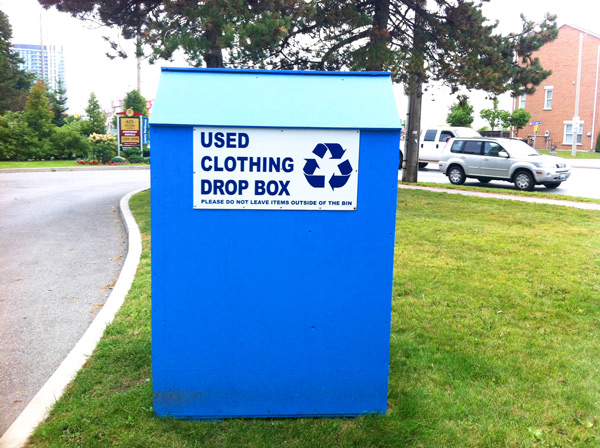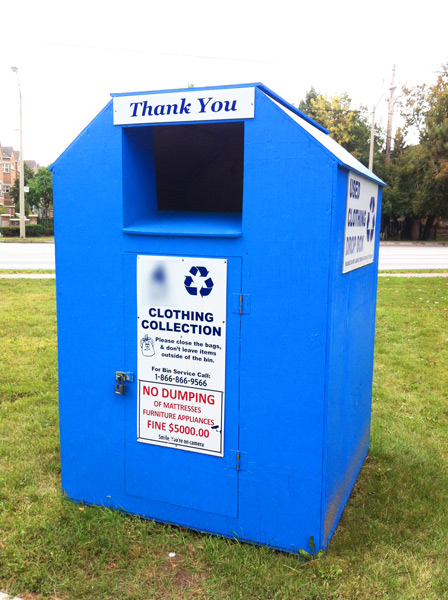by Howard Moscoe You’ve just cleaned out your closets and have a lot of good used clothing to give away. There is a clothing drop box at the corner of the plaza nearby so you haul it all there and drop it into the box. It kind of makes you feel warm and fuzzy because your used clothing donation has gone to help a charity to help others. I’m sorry to have to tell you this, but many of these boxes are not run by charitable organizations. One of the most common boxes in Downsview is a $6 Million a year business which has little, if any, charitable component. In fact, many boxes in Toronto are operated by contractors who pay the charities listed for the use of their name. You can find the names of some pretty exotic charities on clothing drop boxes.
You’ve just cleaned out your closets and have a lot of good used clothing to give away. There is a clothing drop box at the corner of the plaza nearby so you haul it all there and drop it into the box. It kind of makes you feel warm and fuzzy because your used clothing donation has gone to help a charity to help others. I’m sorry to have to tell you this, but many of these boxes are not run by charitable organizations. One of the most common boxes in Downsview is a $6 Million a year business which has little, if any, charitable component. In fact, many boxes in Toronto are operated by contractors who pay the charities listed for the use of their name. You can find the names of some pretty exotic charities on clothing drop boxes. Here’s how it works. The company assigns an area to a contractor. The Downsview contractor then drops as many boxes as he can wherever he can. You will often find the boxes at the edge of shopping plazas or on city property near the road allowance. The plaza owner doesn’t object because, after all, it is a ‘charity’ box and besides, most property owners aren’t quite sure where their property ends and city property begins. The boxes are often on the property line. In 2006, I had Toronto city Council pass a bylaw prohibiting the location of these boxes on city Property. It did little good because enforcement of the bylaw is almost non-existent. The used clothing is taken to a depot where it is sorted by low wage workers into piles. The best clothing is sold to second hand clothing stores. Much of it shipped to third world countries where it is sold for profit. A group of Ryerson Journalism Students once followed a T-shirt they “donated” in one of these boxes to Guatemala where it was sold in an open air market. Some of these business hides behind charities that lend them their names in exchange for a small monthly or yearly donation. One set of clothing boxes displayed pictures of missing children listed as being owned by a ‘charity’ called “The garden of Lost Children.” I tracked it down to one lady in rural Nova Scotia who said she was paid $500 a year for the use of her charity’s name. It was so egregious that the Attorney General of Ontario ordered their name off the boxes. As chair of Licensing, I made two attempts to regulate the industry. The first bylaw the city passed in 2007 was completely unenforceable. I managed to get the city to re-write the bylaw three years ago before I retired. The bylaw is simple. Every box must have a permit. To obtain a permit for a location the operator must have the written permission of the owner, must be free of graffiti, and the operator must keep the area around the box clean and tidy. Sounds easy, but the city has still not put an effective enforcement mechanism in place. I have been trying to get rid of one such illegal box for ten years. Every time the contractor has been asked to move it, he simply lifts it up and drops it on another property. I intend to harass city council until they do something to actually enforce this bylaw. When donating your used clothes, be sure to look for a city of Toronto license sticker on a box. Every legitimate box must be licensed and If there is no city sticker prominently displayed on the box it is an illegal box. Do not leave your clothing. Take it to one of the charities that operate thrift stores.
Here’s how it works. The company assigns an area to a contractor. The Downsview contractor then drops as many boxes as he can wherever he can. You will often find the boxes at the edge of shopping plazas or on city property near the road allowance. The plaza owner doesn’t object because, after all, it is a ‘charity’ box and besides, most property owners aren’t quite sure where their property ends and city property begins. The boxes are often on the property line. In 2006, I had Toronto city Council pass a bylaw prohibiting the location of these boxes on city Property. It did little good because enforcement of the bylaw is almost non-existent. The used clothing is taken to a depot where it is sorted by low wage workers into piles. The best clothing is sold to second hand clothing stores. Much of it shipped to third world countries where it is sold for profit. A group of Ryerson Journalism Students once followed a T-shirt they “donated” in one of these boxes to Guatemala where it was sold in an open air market. Some of these business hides behind charities that lend them their names in exchange for a small monthly or yearly donation. One set of clothing boxes displayed pictures of missing children listed as being owned by a ‘charity’ called “The garden of Lost Children.” I tracked it down to one lady in rural Nova Scotia who said she was paid $500 a year for the use of her charity’s name. It was so egregious that the Attorney General of Ontario ordered their name off the boxes. As chair of Licensing, I made two attempts to regulate the industry. The first bylaw the city passed in 2007 was completely unenforceable. I managed to get the city to re-write the bylaw three years ago before I retired. The bylaw is simple. Every box must have a permit. To obtain a permit for a location the operator must have the written permission of the owner, must be free of graffiti, and the operator must keep the area around the box clean and tidy. Sounds easy, but the city has still not put an effective enforcement mechanism in place. I have been trying to get rid of one such illegal box for ten years. Every time the contractor has been asked to move it, he simply lifts it up and drops it on another property. I intend to harass city council until they do something to actually enforce this bylaw. When donating your used clothes, be sure to look for a city of Toronto license sticker on a box. Every legitimate box must be licensed and If there is no city sticker prominently displayed on the box it is an illegal box. Do not leave your clothing. Take it to one of the charities that operate thrift stores.
2 Champagne Drive - Unit C9
Toronto, Ontario, M3J 0K2
(647) 478-8752
The Voice of Downsview
Your Custom Text Here
